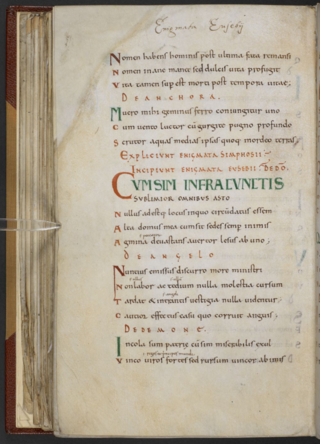Top Qs
Timeline
Chat
Perspective
Enigmata Eusebii
From Wikipedia, the free encyclopedia
Remove ads
The Enigmata Eusebii (riddles of Eusebius) are a collection of sixty Latin, hexametrical riddles composed in early medieval England, probably in the eighth century.

Example
An example of Eusebius's work is enigma 42, on the dragon:[1]: 252
Remove ads
Authorship
The manuscripts of the riddles name the author as Eusebius. This person has traditionally been identified as Hwætberht, the Abbot of Monkwearmouth-Jarrow Priory, based on Bede's identification of Hwætberht with the cognomen of 'Eusebius' in his Commentary on I Samuel.[2][3] However, the identification with Hwætberht has been questioned by several scholars, including Emily V Thornbury, who has suggested that a Kentish author might be likely.[4]
Remove ads
Origins
The Enigmata Eusebii seem to have been composed to expand on the forty riddles of Tatwine, a collection composed by the eighth-century Mercian priest and archbishop Tatwine, perhaps specifically to bring their number up to one hundred: the riddles of Tatwine and Eusebius both survive in the same two manuscripts, and in both the riddles of Eusebius are alongside Tatwine's. These are the early 11th-century London, British Library, Royal 12.Cxxiii (fols. 121v-7r) and the mid-11th-century Cambridge, University Library, Gg.5.35 (fols. 374v-77v). Both of these collections were almost certainly inspired by the slightly earlier riddles of Aldhelm, another collection of one hundred Latin riddles.[5][6] Many of Eusebius's riddles (and his predecessors') are based on the encyclopaedic writing of Isidore of Seville.[citation needed]
Contents
Summarize
Perspective
Riddles 1-4 of Eusebius's riddles are on the chain of being, from God to Man, 5-11 mostly on cosmological phenomena, 12-29 a miscellaneous collection mostly of objects, 30-36 mostly on writing, and 37-60 on animals.[7] The following is a complete list.[1]
Remove ads
References
Wikiwand - on
Seamless Wikipedia browsing. On steroids.
Remove ads
